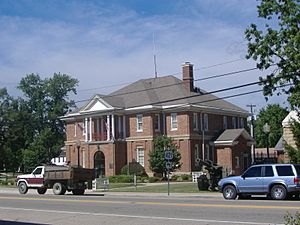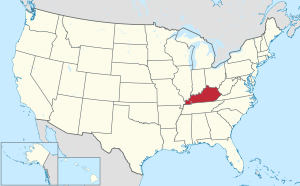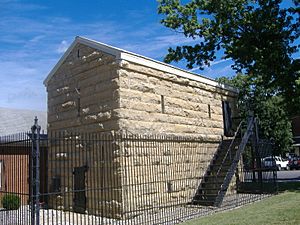Trimble County, Kentucky facts for kids
Quick facts for kids
Trimble County
|
|
|---|---|

Trimble County Courthouse in Bedford
|
|

Location within the U.S. state of Kentucky
|
|
 Kentucky's location within the U.S. |
|
| Country | |
| State | |
| Founded | February 9, 1854 |
| Seat | Bedford |
| Largest city | Milton |
| Area | |
| • Total | 156 sq mi (400 km2) |
| • Land | 152 sq mi (390 km2) |
| • Water | 4.6 sq mi (12 km2) 2.9% |
| Population
(2020)
|
|
| • Total | 8,474 |
| • Estimate
(2023)
|
8,607 |
| • Density | 54.32/sq mi (20.97/km2) |
| Time zone | UTC−5 (Eastern) |
| • Summer (DST) | UTC−4 (EDT) |
| Congressional district | 4th |
Trimble County is a county located in the north-central part of Kentucky. It was started in 1837 and is named after Robert Trimble. The main town, or county seat, is Bedford. Trimble County is part of the larger Louisville area, which includes parts of Kentucky and Indiana.
Contents
Geography of Trimble County
Trimble County covers about 156 square miles. Most of this area, 152 square miles, is land. The rest is water. This makes it one of the smallest counties in Kentucky.
The Ohio River forms the county's western border with Indiana. A ridge runs through the middle of the county. To the east of this ridge, you'll find the Little Kentucky River and other creeks like Daughtery, Buck, and Carmen Creeks. To the west, there are creeks like Spring, Corn, Middle, Patton's, and Barebone Creeks. These creeks flow into the Ohio River.
Neighboring Counties
Trimble County shares borders with these other counties:
- Jefferson County, Indiana (to the northwest)
- Carroll County (to the east)
- Henry County (to the southeast)
- Oldham County (to the southwest)
- Clark County, Indiana (to the west)
Power and Industry
Trimble County is home to the Trimble County Generating Station. This is a large power plant run by LG&E and KU. It helps provide electricity to about 1 million people in Kentucky.
The plant is located on 2,200 acres along the Ohio River. It is known for being one of the most environmentally friendly coal-fired plants in the country. There have been discussions about how the plant handles its coal ash waste. The EPA has suggested that the waste could be moved to an underground mine in another county.
People of Trimble County
| Historical population | |||
|---|---|---|---|
| Census | Pop. | %± | |
| 1840 | 4,480 | — | |
| 1850 | 5,963 | 33.1% | |
| 1860 | 5,880 | −1.4% | |
| 1870 | 5,577 | −5.2% | |
| 1880 | 7,171 | 28.6% | |
| 1890 | 7,140 | −0.4% | |
| 1900 | 7,272 | 1.8% | |
| 1910 | 6,512 | −10.5% | |
| 1920 | 6,011 | −7.7% | |
| 1930 | 5,348 | −11.0% | |
| 1940 | 5,601 | 4.7% | |
| 1950 | 5,148 | −8.1% | |
| 1960 | 5,102 | −0.9% | |
| 1970 | 5,349 | 4.8% | |
| 1980 | 6,253 | 16.9% | |
| 1990 | 6,090 | −2.6% | |
| 2000 | 8,125 | 33.4% | |
| 2010 | 8,809 | 8.4% | |
| 2020 | 8,474 | −3.8% | |
| 2023 (est.) | 8,607 | −2.3% | |
| U.S. Decennial Census 1790–1960 1900–1990 1990–2000 2010–2020 |
|||
In 2010, about 8,809 people lived in Trimble County. The county has grown over the years. In 2023, the population was estimated to be around 8,607 people.
Most people living in Trimble County are White. There are also smaller groups of Black or African American, Native American, and Asian residents. Some people are from two or more races. A small percentage of the population is Hispanic or Latino.
The average age of people in the county in 2010 was 36 years old. About 26% of the population was under 18 years old.
Towns and Communities
Trimble County has two main towns and several smaller communities.
Main Towns
- Bedford is the county seat. This means it's where the county government is located. It sits where two main highways, U.S. 421 and U.S. 42, meet.
- Milton is the oldest town in the county. It is a port town located on the Ohio River, across from Madison, Indiana. Milton used to be the largest town in the county.
Smaller Communities
- Wise's Landing was once a busy port town in the 1800s. Today, it is a much smaller community. It is located near Corn Creek.
- Abbott was a small settlement that had a post office in the past. Its exact location has been debated over the years.
- Ewingford was a small community with stores and a sawmill in the 1800s.
- Providence used to be known as "Hammels' Store." It was renamed Providence after a local church.
- Monitor is another small community that had a post office.
Before schools were centralized and mail delivery became common, Trimble County had many small schools and post offices scattered throughout the area.
Cities
Unincorporated communities
See also
 In Spanish: Condado de Trimble para niños
In Spanish: Condado de Trimble para niños


